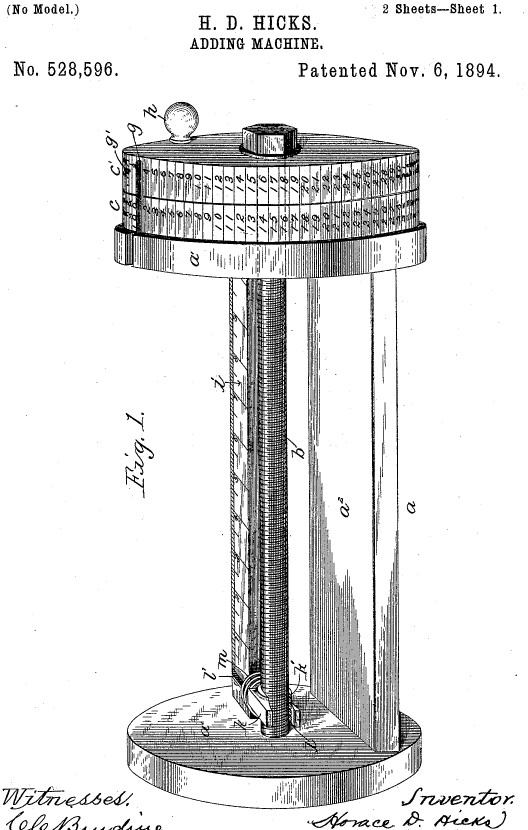Horace Hicks
On 6 November 1894, Horace David Hicks, an employee of Brown’s Lumber Company, Whitefield, New Hampshire, USA, got a patent (US patent 528596, assigned one-half to Brown’s Lumber Company) for adding machine with very interesting construction. Certainly, the adding device of Hicks remained only on paper and never went in serial production, but nevertheless it deserves our attention for its originality..
Let’s see how the inventor described his device in the patent application: My invention relates to that class of adding machines which employ wheels having numbers on the peripheries; and my object is to provide a more simple, and inexpensive device which can be handled and operated with greater ease than those heretofore in vogue. To accomplish these ends, I employ the two co-operating numbered wheels in conjunction with a screw or worm shaft.
Let’s examine the operation of the device, using the patent drawing (see the image below).
 The patent drawing of the adding machine of Horace Hicks
The patent drawing of the adding machine of Horace Hicks
In using the device the pointer k, is first set at the first point on the scale-bar as seen in the figure, and the disks turned to bring the 100 point beneath the arm g. Supposing it is desired to add the numbers 10, 20, and 70; advance the wheels until figure 10 on disk c’ appears beneath the arm. Then turn the disk back until it is arrested by the detent g’. The disk c is carried forward with the disk c’, but is held still by the pawl d2 when the disk c’ is returned to the starting point. A second advance of the wheel c’ to bring the point 20 beneath the arm, and another return movement will cause the disk c to register 30, the sum of the two numbers. If the disk c’ is now advanced to 70 and returned to the starting point, it will have caused the other disk to register a total of 100, and the pointer k to advance one point on the scale-bar. This operation can be continued until the sum of ten thousand has been registered, and then by returning the pointer to the starting point at the left end of the bar, increased additions can be made.
The operation of disengaging the pointer to slide it back, can easily be performed by simply pressing it away from the threaded bar b, against the tension of the spring m, and sliding it to the starting point.
Biography of Horace Hicks
Not a whole lot is known about the inventor Horace Hicks.
Horace David Hicks was born on 23 April 1826, in Jefferson, Coos County, New Hampshire, USA. He was the firstborn of David Hicks (1796–1889), a local farmer, and Eliza (Garland) Hicks (1803–1867).
David Hicks, son of Benjamin (1763-1846) and Alice (Hight) Hicks (1762-1846), was born at Jefferson, on 27 Aug. 1796, one of seven children. He was a descendant of the early settlers Hicks brothers: Robert, who came to the New World on the board of ship Fortune to Plymouth, Massachusetts, on 11 Nov. 1621, or his brother Thomas, who emigrated to America about 1630.
In 1818 David Hicks bought a farm of one hundred acres, which became his permanent home. He was a natural mechanic, and his skill was in demand for making nice wood-work like spinning wheels, clock real and the like (so Horace obviously derived the natural endowments of his father). A quiet, law-abiding (but very fond of his rod and gun and of trapping) and much respected citizen he was called deacon in his later years.
On 25 Dec. 1824, David Hicks married Eliza, daughter of John and Betsy (Hight) Garland, and they had six children: Horace (1826-1905), Elizabeth C. (1829-1911), Alice Jane (1832-1856), John Austin (1836-1896), Joseph Garland (1844-1906), and Harriet (1846-1872).
David Hicks died at Jefferson on 4 Nov. 1889, and his wife Eliza died on 30 Sep. 1867.
Horace Hicks worked 30 years for Brown’s Lumber Company at Whitefield, New Hampshire (a town, located some 10 km west of his hometown Jefferson), once the largest mill of its kind in New England. His brother-in-law Nathan Randall Perkins (married to Horace’s sister Elizabeth) was the second president of the company.
 Brown’s Lumber Company, Whitefield, New Hampshire
Brown’s Lumber Company, Whitefield, New Hampshire
Besides the above-mentioned patent for adding machine, Horace Hicks was a holder of another US patent (Nr. 246504) for belt fastener.
Horace Hicks married to Frances P. Dennis (25 Apr. 1835-24 Aug. 1904), native from England. They had one child, Alice J. (9 Mar 1854-11 May 1854), who died as a baby.
Horace David Hicks died on 15 September 1905, at Jefferson, NH, and was buried in the local Hillside Cemetery.
Up Next…
Interested in finding out about other influential individuals who changed our world forever? Read the following articles below:
- Konrad Zuse – Biography, History and Inventions: He was drawn to both art and engineering. But in the end, the latter won out. Find out what paths he tread as a result of that choice.
- Elizur Wright – Biography, History and Inventions: He was a man of many talents, fluent in Greek, and an excellent mathematician. He also patented a form of the cylindrical slide rule. This article is a brief account of his life.
- Alessandro Volta – Biography, History and Inventions: Although his guardians had envisioned a different future for him, he made up his mind to be a physicist. Find out what he got up to and what he invented, here.
Want to Retire Early? Start Here (Sponsor)
Want retirement to come a few years earlier than you’d planned? Or are you ready to retire now, but want an extra set of eyes on your finances?
Now you can speak with up to 3 financial experts in your area for FREE. By simply clicking here you can begin to match with financial professionals who can help you build your plan to retire early. And the best part? The first conversation with them is free.
Click here to match with up to 3 financial pros who would be excited to help you make financial decisions.
The image featured at the top of this post is ©G-Stock Studio/Shutterstock.com.
